유네스코 한국 기록유산을 세계인들에게 이야기하며 직지를 알려요!
여러분 혹시 아시나요? 전 세계인들은 한국 하면 한국의 전통문화와 역사보다는 한국의 경제발전과 현대 한국의 모습에만 치우쳐 있습니다.
2012년 국가브랜드위원회와 삼성경제연구소가 26개국 오피니언 리더 1만 3천500명을 대상으로 국가 브랜드 지수를 조사한 결과 한국의 과학기술은 4위, 문화 9위, 경제 15위였지만 전통문화는 29위로 나타났습니다. 한국이 5천 년 역사와 찬란한 문화를 가진 문화 대국이지만 아직 세계인은 한국의 역사와 문화를 제대로 모르고 있는 상황입니다. 따라서 한국의 역사와 문화를 세계에 적극적으로 알리는 노력이 필요합니다.
그렇다면 어떻게 하면 세계인들에게 한국을 효과적으로 알릴 수 있을까요? 국제적으로 공인된 유네스코 한국 기록유산을 통해 전 세계 외국인들에게 알려지지 않은 한국의 역사와 기록 문화유산을 세계인들에게 알려주세요.
한국은 유네스코 세계기록유산 보유 아시아 1위, 세계 3위 국가입니다. 양뿐만 아니라 질적인 면을 합해 평가하면 세계기록유산 1위의 국가라 해도 과언이 아닙니다. 따라서 직지와 같은 유네스코 세계기록유산을 해외에 홍보하면 할수록 이와 맞물려 씨줄과 날줄로 연결된 한국의 5000년 역사 또한 세계인에게 알려지게 될 것입니다.
 2001년 등재, 인류 인쇄 역사의 중요한 기술적 변화를 보여주는 금속활자
2001년 등재, 인류 인쇄 역사의 중요한 기술적 변화를 보여주는 금속활자
<직지>는 한국의 고려 시대(918-1392) 말 승려 백운화상이 석가모니와 선친 승려들의 가르침을 편집하여 기록한 ‘백운화상초록불조직지심체요절’을 그의 제자 석찬과 달잠이 금속활자로 인쇄한 책이다. 현존하는 가장 오래된 금속활자본인 <직지>는 1377년 청주 흥덕사에서 간행되었다. 현재까지 상·하권 중 하권만이 발견되었고, 이는 프랑스 국립도서관에 소장되어 있다. 인류 역사에 큰 영향을 준 금속활자로 인쇄되었고, 현존하는 가장 오래된 금속활자인쇄본이며, 오직 한 권만이 남아있다는 희귀성과 그 가치를 인정받은 세계 기록유산이다.
The Oldest Extant Book Printed with Movable Metal Type Jikji/ Designated in 2001
Evidence of important technological advancement in the world’s printing history
Jikji, short for Baekunhwasang Chorok Buljo Jikji Simche Yojol, is a book that was compiled from Buddhist scriptures by the monk Baekun Hwasang and printed with movable metal type by his disciples, Seokchan and Daljam during the late Goryeo Dynasty (918~1392). It was published at Heungdeok Temple in 1377, and became the oldest surviving book printed with movable metal type. The book was printed in two volumes, but only the second volume was found and is currently housed at the National Library of France. Jikji is recognized for its outstanding universal value because of its rarity and historical significance as the world’s oldest extant book printed with movable metal type, an invention that had a profound impact on human history.
 1997년 등재, 조선왕조 500년을 기록한 세계 최대의 단일 왕조 역사책
1997년 등재, 조선왕조 500년을 기록한 세계 최대의 단일 왕조 역사책
<조선왕조실록>은 한국의 조선 시대(1392~1910) 1대 왕 태조부터 25대 철종까지 472년의 역사를 기록한 역사서로써 조선의 정치·외교·사회·경제·학술·종교·천문·지리·음악뿐만 아니라 중국, 일본, 몽골 등 주변국의 상황도 수록되어 있어 동아시아 역사 연구의 중요 자료이다. 실록은 각 왕의 재위 기간별로 분류되며, 선왕이 죽고 나서야 관련 기록을 모아 인쇄를 하였다. 임금도 절대 볼 수 없을 뿐만 아니라 기록의 익명성을 보장하여 객관성과 공정성이 완벽에 가까운 역사서이다. 왕의 권력을 견제한 역사의식과 기록 정신이 빛나는 세계적인 기록유산이다.
Culmination of Extensive Documentation with Accuracy and Objectivity Joseon Wangjo Sillok (The Annals of the Joseon Dynasty)/ Designated in 1997
The world’s longest continuous record of a single dynasty, covering all 500 years of Joseon
Joseon Wangjo Sillok is a documentation of 472 years of the Joseon Dynasty (1392~1910), starting with the first king Taejo through the 25th king Cheoljong. It has great value for the study of East Asian history because it contains detailed accounts of Joseon’s politics, diplomacy, society, economy, literature, religion, astronomy, geography, and music, as well as the situations of neighboring countries, including China, Japan, and Mongolia. It is categorized according to the reign of each king. To protect its accuracy and objectivity, historians didn’t identify their names and compiled accounts after the previous king’s death. Even kings were not allowed to review the record. Joseon Wangjo Sillok is an important part of the world’s documentary heritage that represents historians’ rigorous efforts to pass down accurate and unbiased accounts of history.
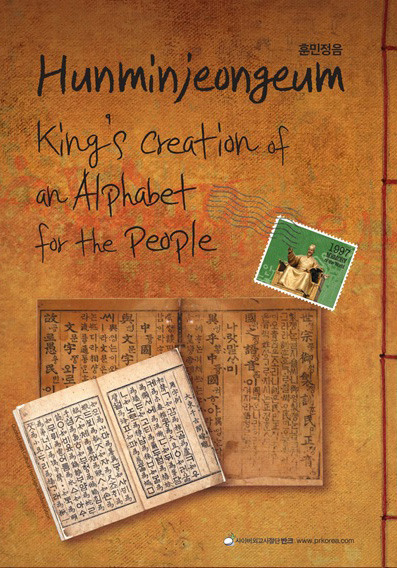 1997년 등재, 문자의 개발자와 그 개발 의도가 분명한 세계 유일의 문자
1997년 등재, 문자의 개발자와 그 개발 의도가 분명한 세계 유일의 문자
<훈민정음>은 백성을 가르치는 올바른 소리라는 뜻으로, 창제 당시 한글의 이름이다. 한글이 창제되기 전 중국의 문자인 한자를 빌려 사용해 한국어의 체계와 맞지 않았고, 어렵고 복잡한 한문의 체계로 문맹률이 높았다. 백성들의 어려움을 안타깝게 여긴 조선의 4대 임금인 세종대왕(1397-1450)은 백성들이 쉽게 익히고 사용할 수 있도록 1443년 28개의 글자로 이루어진 한글을 창제했다. 세계의 문자 가운데 유일하게 한글만이 문자를 만든 사람, 만든 날, 만든 이유와 목적, 글자를 만든 원리까지 기록된 유산이다.
King’s Creation of an Alphabet for the People Hunminjeongeum / Designated in 1997
The world’s only alphabet whose creator and purpose of creation are known
Hunminjeongeum, the original name of Hangeul, means proper sounds to instruct the people.
Before its creation, Koreans used Chinese characters for their writing. Chinese characters did not adequately represent the sounds of the Korean language and were too difficult to learn for commoners, resulting in a high illiteracy rate. Understanding the troubles of commoners, King Sejong (1397~1450), the fourth ruler of Joseon, created the Korean native alphabet called Hunminjeongeum in 1443. It consisted of 28 letters that are easy to learn for anyone. Hunminjeongeum has outstanding universal value as the world’s only alphabet whose creator, date, purpose, and principles of creation were clearly documented.
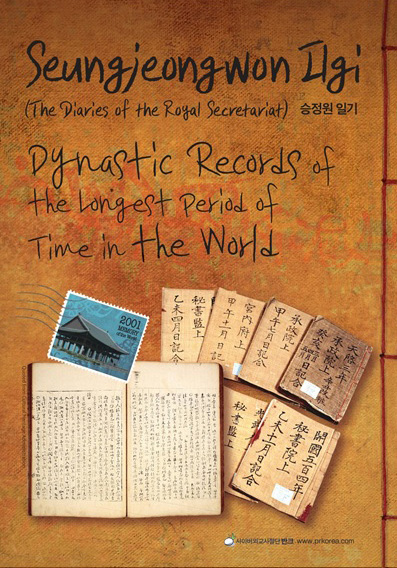 2001년 등재, 왕의 일거수일투족을 일기체로 적은 세계 최장의 연속 기록물
2001년 등재, 왕의 일거수일투족을 일기체로 적은 세계 최장의 연속 기록물
<승정원일기>는 한국 조선 시대 임금의 비서실인 승정원에서 국왕을 가장 가까이에서 모시며 매일 임금의 모든 것을 기록한 일기이다. 왕의 기분과 분위기까지 상세히 기록되었으며, 특히 날씨까지 기록되어 있어, 동북아지역의 최근 3백 년간의 기후를 알 수 있는 귀중한 역사 자료이다. 조선 초부터 작성되었지만, 절반이 전쟁으로 소실되었고, 지금은 1623년 3월부터 1910년 8월까지 288년간의 기록이 남아있으며 총 3,245권, 2억 3천만 자에 달하는 단일 서책으로 가장 방대한 기록물이다.
Dynastic Records of the Longest Period of Time in the World Seungjeongwon Ilgi (The Diaries of the Royal Secretariat)/ Designated in 2001
The world’s longest continuous record of kings’ daily life
Seungjeongwon Ilgi is a collection of the daily records of royal court affairs that was created and maintained by Seungjeongwon, the royal secretariat during the Joseon Dynasty. Royal secretaries kept detailed records of the king’s mood, his daily routines, and weather of the day. These diaries provide valuable historical records of climate change in the past 300 years in Northeast Asia. Writing began in the early Joseon, but about half were destroyed by fire during the Imjin War. The surviving portion includes 3,245 books written in 230 million characters that covered 288 years between March 1623 and August 1910. It is recognized for having the largest amount of authentic historic recordings in a single series.
 2007년 등재, 나라를 지키기 위한 염원을 담은 5천2백만 개의 문자가 담긴 현존하는 가장 완벽한 대장경
2007년 등재, 나라를 지키기 위한 염원을 담은 5천2백만 개의 문자가 담긴 현존하는 가장 완벽한 대장경
<고려대장경판>은 몽고의 침입으로 위기에 빠진 고려를 불교의 힘으로 구하고자 하는 마음으로 새겨진 대장경판으로 목판의 수가 총 81,258판에 달해 ‘팔만대장경’이라고도 불린다. 대장경은 불교 경전을 집대성한 것으로 부처의 말씀인 경, 승려의 계율인 율, 학덕 높은 승려의 주석인 론으로 구성된다. <제경판>은 대장경을 보완하기 위해 만든 판으로 5,987개의 판이 해인사에 보관되어 있다. 제작 기간 16년, 동원인력 5만 명의 초대형 국책사업으로 당시 대장경을 만들 수 있는 나라는 한국의 고려(918~1392)와 중국밖에 없었다는 점에서 의의가 있으며, 대장경 보관 건물인 장경각(유네스코 세계문화유산)이 과학적으로 설계된 덕분에 잘 보존되어 지금도 명확히 인쇄할 수 있다는 점에서 더 훌륭한 기록유산이다.
Evidence of Cultural Victories through Patriotism Printing Woodblocks of the Tripitaka Koreana and Miscellaneous Buddhist Scriptures / Designated in 2007.
The world’s most comprehensive Tripitaka, written in 52 million characters, in hope of protecting the nation .
The Goryeo Daejanggyeong (Tripitaka Koreana) was created in a hope to protect the nation from Mongolian invasion by summoning the power of the Buddha. It is commonly known as the Palman Daejanggyeong, meaning Eighty Thousand Tripitaka in Korean, because Buddhist scriptures were carved onto 81,258 wooden printing blocks. The Daejanggyeong or the Tripitaka is a collection of Buddhist scriptures that consist of Gyeong, the Buddha’s teaching, Yul, rules for monks, and Ron, revered monks’ annotations. An additional 5,987 miscellaneous woodblocks were created to supplement the Daejanggyeong, and are currently stored at Haeinsa Temple. It was a large-scale national project that took 16 years and involved 50,000 people. The Goryeo Daejanggyeong is of particular historical value because Goryeo (918~1392) and China were the only two countries with the ability to create such work. Janggyeonggak Panjeon, the depository for the Daejanggyeong, is also registered as a UNESCO heritage site. Due to its scientific design, the Daejanggyeong is so well preserved that it enables clear printing to this day, which increases its value as documentary heritage.
 2007년 등재, 한국 조선 시대 왕실의 의례에 대한 500년 동안의 치밀한 기록
2007년 등재, 한국 조선 시대 왕실의 의례에 대한 500년 동안의 치밀한 기록
<조선왕조 「의궤」>는 왕실의 중요 의식에 관한 기록물로 행사에 필요한 각종 문서 및 업무 분장표, 동원 인원, 소요 물품, 경비뿐만 아니라 행사의 전 과정을 그림으로 남긴 3,895권의 책으로 구성되어있다. 당시의 중요 국가 행사와 의식에 대한 방법과 모습이 포괄적이고 체계적으로 모여 생생하게 확인할 수 있을 뿐만 아니라, 시대와 주제별로 구성되어 왕실 행사의 변화 양상과 동시대 동아시아 국가의 행사 모습과 자세히 비교할 수 있다는 귀중한 가치가 있다.
Essence of Accurate and Meticulous Record Keeping during Joseon Uigwe (The Royal Protocols of the Joseon Dynasty)/ Designated in 2007.
Detailed record of the Joseon Dynasty’s royal protocols for 500 years.
The Uigwe is a collection of records that documented major royal ceremonies during Joseon. It consists of 3,895 books that illustrate entire procedures with documentation of work charts, participants, goods, and costs. It provides comprehensive and systematic representations of important national events and rituals of the time. Also, due to its categorization by topic and time period, it enables an observation of changes in royal ceremonies and the comparison of national ceremonies between East Asian countries at the time.
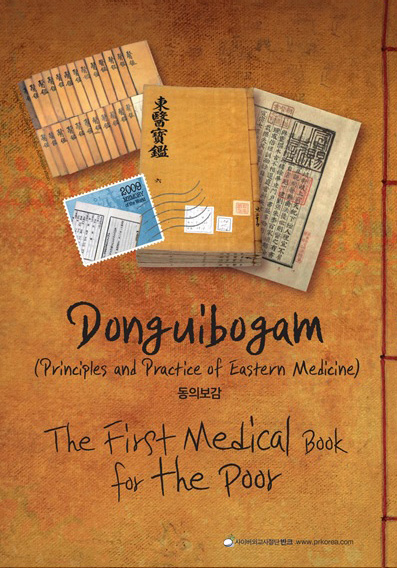 2009년 등재, 2,000년 동안 축적된 동양 의학 이론을 집대성한 현존하는 최고의 동양 임상의학서
2009년 등재, 2,000년 동안 축적된 동양 의학 이론을 집대성한 현존하는 최고의 동양 임상의학서
동양 의학의 이론과 실제라는 뜻의 <동의보감>은 한국의 조선 시대 국왕의 주치의였던 허준(1546~1615)이 15년간의 연구와 임상시험을 통해 1613년 한국에서 편찬된 백과사전식 의학서이다. 백성들의 의료에 절대적 영향을 미쳤던 중국 의학에서 벗어나 한국인의 체질에 맞는 질병 예방법과 치료법을 담았으며, 한국에서 쉽게 구할 수 있는 약재를 일반 백성들도 쉽게 이해할 수 있도록 한글로 표기하였다. 17세기 조선에서 보여주는 공공의료에 대한 가치뿐만 아니라 오늘날까지도 한의학도들에게 널리 읽히고 있는 귀중한 동양의 의학서이다.
The First Medical Book for the Poor Donguibogam (Principles and Practice of Eastern Medicine)/ Designated in 2009.
The most comprehensive medical book, compiling 2,000 years of Eastern medicine knowledge.
Donguibogam means the theory and practices of Eastern medicine. It is an encyclopedic medical book compiled by the royal physician Heo Jun (1546~1615) and published in 1613. Heo spent 15 years on research and clinical trials to complete this book. He included preventive measures and treatments suited for Korean bodies, and provided the names of accessible herbs in Korean to help ordinary people. Donguibogam was distinguished from previous medical books that were under the dominant influence of Chinese medicine. It is an example that indicates Joseon’s interest in public health care in the 17th century. Donguibogam is still valuable literature about Eastern medicine for medical students.
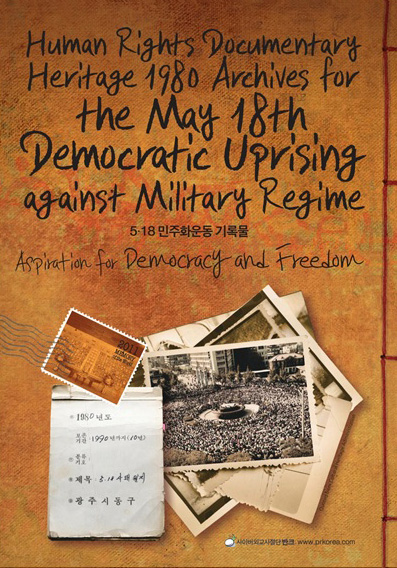 2011년 등재, 인간으로서 마땅히 누려야 할 기본적 권리인 ‘인권’과 그 인권을 지켜내기 위한 투쟁의 기록
2011년 등재, 인간으로서 마땅히 누려야 할 기본적 권리인 ‘인권’과 그 인권을 지켜내기 위한 투쟁의 기록
<1980년 인권기록유산 5·18 민주화운동 기록물>은 인간의 존엄성을 망가뜨리는 국가의 억압과 폭력에 맞서 민주주의와 인권을 외친 국민들의 저항을 담은 기록물이다. 부당한 국가 권력에 대항한 시민들의 활동과 이후 피해자 보상에 관한 문서, 사진 자료 등을 포함하고 있다. 5·18민주화운동은 당시 아시아 여러 국가의 민주화 운동과 인권 운동에 큰 영향을 주었을 뿐만 아니라, 지금까지도 민주주의와 그 핵심 가치인 인권에 대한 가치를 상징적으로 보여주고 있다.
Aspiration for Democracy and Freedom Human Rights Documentary Heritage 1980 Archives for the May 18th Democratic Uprising against Military Regime/ Designated in 2011 Record of fights to protect fundamental human rights
Human Rights Documentary Heritage 1980 Archives for the May 18th Democratic Uprising against Military Regime is a documentary heritage item that recorded people’s resistance to the oppressive government and its violence in order to bring democracy and defend human rights. The archives include documents, photos, and images that documented grassroots activities against the oppressive regime and compensation for victims. The May 18th Democratic Uprising had a profound impact on other Asian countries’ democratic and human rights movements. It still represents the value of democracy and democratic values, particularly fundamental human rights.
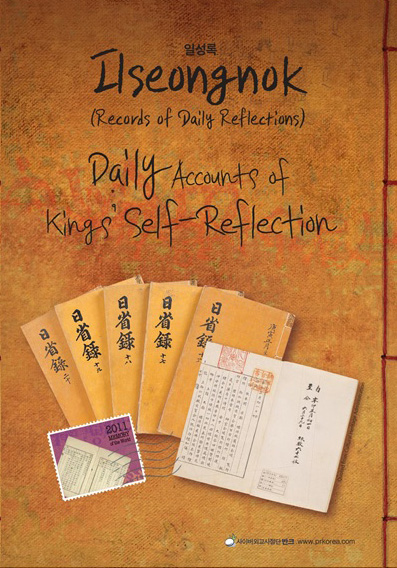 2011년 등재, 한국의 조선시대 후기 왕이 기록한 1760년부터 1910년까지의 왕의 국정 일기
2011년 등재, 한국의 조선시대 후기 왕이 기록한 1760년부터 1910년까지의 왕의 국정 일기
<일성록>은 하루하루를 반성한다는 의미로 국사에 관한 왕의 공식 기록이다. 왕의 동정과 국정 운영 사항을 매일 일기의 형식으로 정리한 151년간의 연대기 기록물이며 총 2,329권의 책으로 구성되어있다. 단순히 한 나라의 역사적 자료로서 가지는 가치를 넘어서 18세기부터 20세기까지 동서양의 정치, 문화적 교류를 파악할 수 있는 기록도 포함하고 있어 세계사적 흐름을 파악하는 데에 유용한 가치를 지니고 있다.
Daily Accounts of Kings’ Self-Reflection Ilseongnok (Records of Daily Reflections)/ Designated in 2011
Joseon King’s diaries covering the period between 1760 and 1910
Ilseongnok means reflecting on the day, and it is the Joseon kings’ official records of state affairs. Kings wrote about their daily life and state affairs. Ilseongnok consists of 2,329 volumes that cover 151 years during the Joseon Dynasty. Beyond its value as a country’s historical data, Ilseongnok has an important use in understanding global historical changes because it includes the records of political and cultural exchanges between the East and the West from the 18th to 20th centuries.
 2013년 등재, 사투를 넘나드는 전쟁 속, 최고 지휘관이 쓴 7년 동안의 일기
2013년 등재, 사투를 넘나드는 전쟁 속, 최고 지휘관이 쓴 7년 동안의 일기
<난중일기>는 한국의 조선 시대 충무공 이순신 장군(1545~1598)이 임진왜란 기간(1592~1598) 동안 매년 1권씩 직접 쓴 7권의 일기이다. 전쟁 기간에 최고 지휘관이 직접 전투 상황과 개인의 감정을 매일 일기로 기록한 세계사적으로 유례를 찾기 힘든 희귀한 기록으로, 생과 사를 오가는 전투 현장을 글로 남겨 후대에 역사의 교훈을 주고자 했던 치열한 기록 정신이 깃든 세계 기록유산이다.
Daily Accounts of an Admiral’s Self-Reflection during a War Nanjung Ilgi (War Diary of Admiral Yi Sun-sin)/ Designated in 2013
Seven years of diaries kept by an admiral during fierce battles
Nanjung Ilgi is a collection of seven volumes of a diary, one for each year, written by Admiral Yi Sun-sin (1545~1598) during the Imjin War (1592~1598). It is a rare record in which a military commander recorded battle situations and personal feelings on a daily basis during a war. It is a documentary heritage item that reflects a strong sense of responsibility to pass on lessons to later generations.
 2013년 등재, 빈곤 퇴치를 위한 지구촌의 모범 사례, 새마을운동(1970~1979)
2013년 등재, 빈곤 퇴치를 위한 지구촌의 모범 사례, 새마을운동(1970~1979)
<새마을운동 기록물>은 한국 전 지역 3만 4천여 개의 마을에서 정부와 민간이 함께 힘을 모아 추진된 농촌 근대화에 대한 종합적인 기록으로, 정부와 민간의 문서, 사진, 영상 등 약 2만 2천여 건이 포함되어 있다. 1950년 6·25전쟁 이후 세계에서 가장 가난한 나라였던 대한민국이 세계 10대 경제 대국으로 성장하는 데에 크게 큰 역할을 한 새마을운동은, 지구촌 빈곤 문제에 대한 하나의 해결 씨앗이 되어 아시아, 아프리카 등 개발도상국 국가들에게 빈곤 퇴치와 농촌개발의 희망과 그 증거가 되고 있다.
Evidence of Hope to End Global Poverty Archives of Saemaul Undong (New Community Movement)/ Designated in 2013
Saemaul Undong (1970~1979), a model example of overcoming poverty
The Archives of Saemaul Undong include 22,000 pieces of governmental and non-governmental documents, pictures, and videos that recorded the process of modernization in 34,000 towns across Korea. Saemaul Undong made a significant contribution to Korea’s transition from one of the world’s poorest countries after the Korean War to one of the world’s top ten economies. It provides hope to developing countries in Asia and Africa that are struggling to overcome poverty and develop their economies.
 2015년 등재, 전쟁에 대한 반성, 평화를 향한 염원
2015년 등재, 전쟁에 대한 반성, 평화를 향한 염원
전쟁과 분단으로 헤어진 760만 명의 이별의 한과 평화를 향한 염원이 담긴 생생한 기록
은 1950년 6·25전쟁으로 남과 북이 나뉜 채, 지금까지도 헤어져 있는 이산가족이 잠시나마 서로의 가족을 찾은 순간이 기록된 자료이다. 한국의 공영방송 KBS가 1983년 6월 30일부터 11월 14일까지 138일, 453시간 45분에 걸쳐 생방송으로 진행한 <이산가족을 찾습니다> 프로그램과 관련된 기록물로 녹화 테이프 463개, 프로듀서 업무 수첩, 이산가족 신청서 등 총 2만 522건의 자료가 포함되어 있다. 통일과 전쟁 없는 세계 평화를 향한 염원을 담은 한국인의 생생한 증언은 진정성, 독창성, 세계적 중요성의 측면에서 높은 가치를 인정받은 유네스코 세계 기록유산이다.
Reflection on a War and Aspiration for Peace The Archives of the KBS Special Live
Broadcast “Finding Dispersed Families”/ Designated in 2015
Records of the tragedies of 7.6 million separated families and their hope for peace
The Archives of the KBS Special Live Broadcast “Finding Dispersed Families” are the records of the moments of short reunion of dispersed families who have been separated since the territorial division after the Korean War. The archives consist of 20,522 items, including 463 video tapes of 453 hours and 45 minutes of broadcast for the 138 days between June 30 and November 14 in 1983, of the live KBS show “Finding Dispersed Families,” as well as producers’ journals and families’ applications. It is recognized for its outstanding universal value because it provides a unique collection of true stories that show aspirations for unification and peace.
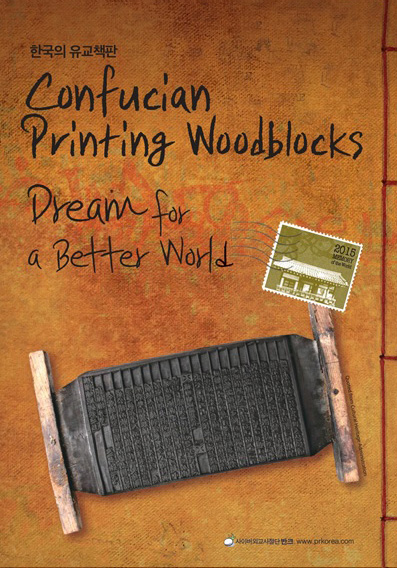 2015년 등재, 한국의 조선 시대 지식인들이 세기를 이어 500년에 걸쳐 만들어낸 집단지성의 통합본
2015년 등재, 한국의 조선 시대 지식인들이 세기를 이어 500년에 걸쳐 만들어낸 집단지성의 통합본
<유교책판>은 16세기부터 20세기 중반까지 국가 중앙 권력이 아닌 각 지역의 지식인들이 중심이 되어 718종의 서책을 간행하기 위해 나무판에 새긴 64,226장 분량의 책판이다. 정치, 경제, 사회, 문화 등 다양한 분야에 걸쳐진 이 책판은 ‘도덕적 인간의 완성’이라는 원대한 꿈이 담겨 있는 유네스코 세계 기록유산이다.
Dream for a Better World Confucian Printing Woodblocks / Designated in 2015
Culmination of collective intelligence work during the 500 years of the Joseon Dynasty
Confucian Printing Woodblocks consist of 64,226 wooden blocks that were created by local intellectuals and used to print 718 kinds of books between the 16th century and the mid-20th century. They cover a variety of areas, including politics, economy, society, and culture. Confucian Printing Woodblocks are important documentary heritage that reflects our constant pursuit to ‘become a moral person.